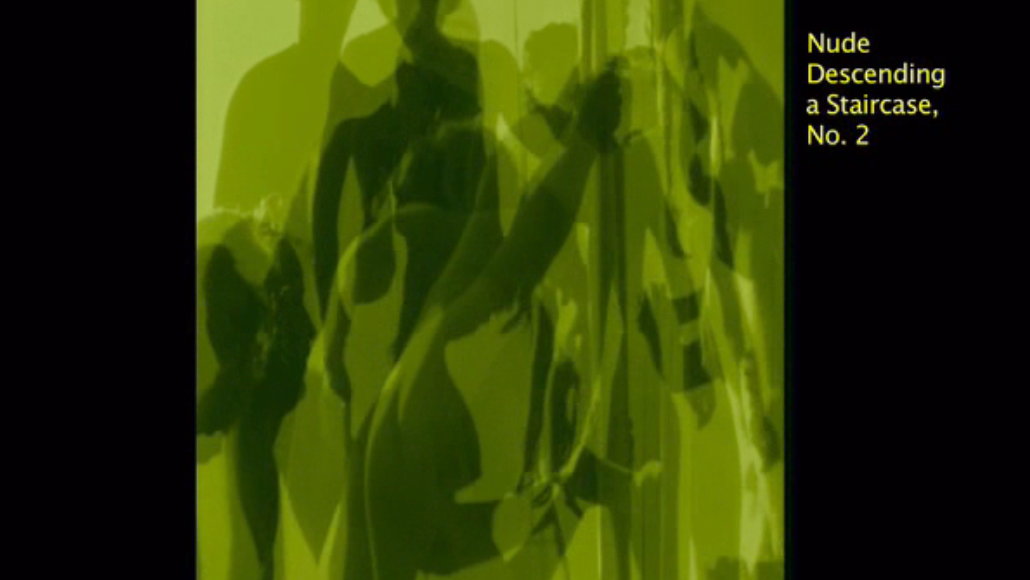Los Angeles-based filmmakers John Cannizzaro, and New York-based Stuart Fordyce, presented two short films on May 18th at The Electric Lodge in Venice. Both films, one an experimental work composed of found footage and the other a documentary short, explore the oft-asked and never-resolved question as to what can and cannot be considered a work of art. Rather than trying to defend the oeuvres of certain artists or individual artworks as being worthy of critical, commercial or institutional regard, both films opt to zoom out—to explore when this question was first asked and who, at various points throughout the 20th century, has been doing the asking.
Cannizzaro’s Follows the Leader (2020) is built around an audio recording of an interview with the artist Marcel Duchamp. The film chops up the tape against a backdrop of recycled clips, most of which are grainy, early to mid-century scenes taken from feature films, commercials and newsreels. There are public safety films warning housewives about the dangers of walking down the stairs in high heels, paired alongside snippets of the early Looney Tunes’ character Bosko.
Duchamp famously subverted the concept of what could be considered art through his production of “readymades”—everyday, industrial objects presented with little to no artistic intervention. However, Duchamp did not view his own works as subversive as his audience did. In his eyes, paint itself was already an industrially produced material, so paintings were just the second step—a sort of readymade composed of readymades.[1]
In Follows the Leader, Cannizzaro questions what could be branded as a readymade in a filmic sense. If paint is the readymade product used to create paintings, then lived reality is the object that lends itself to cinema. The urinal that becomes the sculpture in Duchamp’s most famous readymade Fountain (1917) becomes equivalent to the people and environments that are captured by feature films and documentaries. Splicing these clips and placing them one after another strips them of their context, narrative structure and meaning, in turn emphasizing their object status, making them feel like the readymade object taken from its original context and placed in the museum; in this case, the institution is replaced by the format of the moving image.
Fordyce’s bluntly titled Is This Art? (2022) examines the inverse scenario—what happens when a work of art is taken out of an institutional setting and thrust onto a reluctant public? In 1974, California artist Brooke Larsen was commissioned by Atlantic City, New Jersey, to build a 40-foot tall sculpture as a tribute to the historic boardwalk. The resulting work was a monolithic, brown triangular construction built out of fiberglass and wood. Larsen explains how the gaps created by the sculpture’s slats and various design elements produced a moiré pattern that mimicked the visual effect of standing underneath the boardwalk, observing the sunlight projected onto the sand from above. Shortly after its completion, the work was immediately met with criticism, much of which was published in local newspapers with headlines like “40 Ft. Abstract Sculpture Called ‘Piece of Junk.’”
Though the piece would be considered relatively innocuous by today’s standards, it’s easy to imagine how in 1974, a public unaccustomed to the relatively novel forms of minimalist sculpture would react to something so large and monochrome. This was, after all, seven years before Richard Serra caused a much larger uproar with his public installation Tilted Arc, installed in New York’s Foley Square from 1981 to 1989 before disgruntled Manhattanites brought about its removal. Coincidentally, Larsen’s installation also came just two years before gambling was legalized in Atlantic City in 1976. Ultimately, it was the jeers of the incoming casinos that rang louder than the city’s minimalist-hating citizens, as the gaming authorities were the ones who pressured and ultimately succeeded in having the local government demolish the piece thirteen years after its installation. It seemed that Atlantic City was about to become known for something other than its boardwalk—the casinos had little interest in welcoming gamblers to the city with a hulking monument of its past.
Speaking of Tilted Arc, art critic Calvin Tomkins questioned “whether public spaces and public funds are the right context for work that appeals to so few people—no matter how far it advances the concept of sculpture.”[2] Tomkins is right of course—taxpayers should have a say in how and when the government uses their money to commission works of art and where those works are subsequently placed. But that overlooks the fact that when controversial artworks become the source of public scrutiny, it isn’t the public that ultimately gets to decide their fate. Just as Larsen’s Atlantic City work was killed by the arriving casinos, Tilted Arc’s removal was done less so to create a nice place for bureaucrats to enjoy their lunch and more so to allow for increased government surveillance of the plaza.
Because of these historic examples, it’s important to be wary of those who seize onto public debate surrounding a certain work of art as a trojan horse to propel their own economic or authoritative interests in having that work removed, defunded or disregarded. This is especially important when considering recent attempts to eliminate government funding for the arts[3]—incidentally by the same person who tried, and failed, to capitalize on the legalization of gambling in Atlantic City nearly 50 years ago.[4] The debate over what should or shouldn’t be considered art is one that won’t go away anytime soon. But it’s important to consider who is doing the asking, especially when the question is being asked rhetorically as a means to justify the defunding of arts programming altogether—one can recall conservative criticism of NEA funding of Andres Serrano’s Piss Christ (1987) and the Robert Mapplethorpe retrospective in the ’90s.[5] After all, if the exhibition of Duchamp’s Fountain had been reliant on an NEA grant, would anyone have ever seen it?
[1] https://www.metmuseum.org/toah/hd/duch/hd_duch.htm
[2] Kammen, Michael. Visual Shock. United States: First Vintage Books Edition, 2006. p.241
[3]https://www.washingtonpost.com/news/morning-mix/wp/2017/03/20/behind-the-loathing-of-the-national-endowment-for-the-arts-a-pair-of-despicable-exhibits-almost-30-years-ago/
[4] https://www.theguardian.com/us-news/2021/feb/17/trump-casino-demolished-atlantic-city-failed
[5]https://www.washingtonpost.com/news/morning-mix/wp/2017/03/20/behind-the-loathing-of-the-national-endowment-for-the-arts-a-pair-of-despicable-exhibits-almost-30-years-ago/


